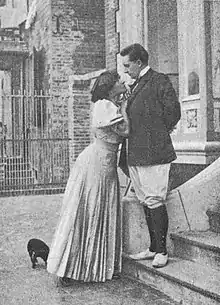Mathilde de Morny
Mathilde de Morny (26 May 1863 – 29 June 1944) was a French aristocrat and artist. Morny was also known by the nickname "Missy" or by the artistic pseudonym "Yssim" (an anagram of Missy), or as "Max", "Uncle Max" (French: Oncle Max), or "Monsieur le Marquis". Active as a sculptor and painter, Morny studied under Comte Saint-Cène and the sculptor Édouard-Gustave-Louis Millet de Marcilly.

Life
Morny was the fourth and final child of Charles de Morny, Duke of Morny and Sofia Sergeyevna Trubetskaya. Charles was the half-brother of Napoleon III, whilst Sofia may have been the illegitimate daughter of Nicholas I of Russia. Although born female, Morny dressed and lived as a man, and used the name Max.
Extravagant conduct made Morny a celebrity of the Belle Époque and despite an 1881 marriage to the well-known gay man Jacques Godart, 6th Marquis de Belbeuf (1850–1906)—whom Morny divorced in 1903—Morny was open about preferring women. Though love between those perceived as women was then fashionable, Morny was attacked for this, especially for having a very masculine dress and attitude. At this time a woman, wearing trousers could still scandalize even if the person was legally authorized, as in the case of Rosa Bonheur (who sought police permission to wear trousers to make it easier for her to paint in the countryside). Missy wore a full three-piece suit (which, as with trousers, was forbidden in France for anyone but men),[1] had short hair, and smoked a cigar.
A scholar of Morny, Kadji Amin, says that—contrary to some claims—no evidence supports the theory that de Morny underwent a hysterectomy or a mastectomy.[2] "Recent historians have claimed that Max de Morny [had such surgery], based on a single, unverified, and never-duplicated claim by Simone Wiel [sic], who, moreover, was not one of de Morny's intimates. It seems unlikely, though not impossible, that someone as notorious and as subject to gossip as de Morny could have had [...] ovaries and breast tissue surgically removed, as Wiel claims, without anyone else having taken note."[2]
As a teenager, Morny had adhered to sartorial convention. An 1882 magazine article describes the newlywed marquise as wearing "a dress of the very palest mauve, mixed tulle and silk," adding that Morny "is not exactly pretty, but has a most original face, being very pale, with a very set expression, the darkest eyes possible, and quantities of very fair hair."[3]

Morny became a lover of several women in Paris, including Liane de Pougy and Colette. From summer 1906 onwards, Colette and Morny lived together in the 'Belle Plage' villa in Le Crotoy, where Colette wrote Les Vrilles de la vigne and La Vagabonde which would be adapted for the screen by Musidora. On 3 January 1907 the two put on a pantomime entitled Rêve d'Égypte ('Dream of Egypt') at the Moulin Rouge, in which Morny caused a scandal by playing an Egyptologist during a love scene with a woman – a kiss between them almost caused a riot and the production was stopped by the prefect of police Louis Lépine. From then on they could no longer live together openly, though the relationship lasted until 1912.[4][5][6] Morny also inspired the character 'La Chevalière' in Colette's novel Le Pur et l'impur, described as "in dark masculine attire, belying any notion of gaiety or bravado... High born, she slummed it like a prince."
On 21 June 1910 the couple bought the manor of Rozven at Saint-Coulomb in Brittany (its owner, baron du Crest, refused the sale because Mathilde was not dressed as a woman and so Colette signed the deed instead) – on the same day the first chamber of the tribunal de grande instance for the Seine departement pronounced Colette's divorce from Henry Gauthier-Villars. When they separated a year later, Colette kept the house.[7]
At the end of May 1944 Morny attempted hara-kiri but was prevented, but did ultimately die from suicide on 29 June 1944, aged 81.
In popular culture
De Morny is a major character in the 2018 film Colette, played by Denise Gough.
References
- Crane, Diana (1999). "Clothing Behavior as Non-Verbal Resistance: Marginal Women and Alternative Dress in the Nineteenth Century". Fashion Theory. Berg Publishers. 3 (2): 241–268. CiteSeerX 10.1.1.602.769. doi:10.2752/136270499779155078. ISSN 1362-704X. (pdf p.16)
- Amin, Kadji (Spring 2013). "Ghosting Transgender Historicity in Colette's The Pure and the Impure". L'Esprit Créateur. Johns Hopkins University Press. 53 (1): 114–130. doi:10.1353/esp.2013.0012. ISSN 0014-0767. (via Project MUSE)
- "Things in Paris," Vanity Fair, 13 May 1882, page 275
- Flower, John (2013). Historical Dictionary of French Literature. Scarecrow Press, page 145
- Rodriguez, Suzanne (2002). Wild Heart: Natalie Clifford Barney and the Decadence of Literary Paris. Harper Collins, p 131
- Benstock, Shari (1986). Women of the Left Bank: Paris, 1900-1940. University of Texas Press, pages 48-49
- Frédéric Maget, president of the Société des Amis de Colette, « Colette en ses demeures », in La Marche de l'Histoire, 28 November 2011
Bibliography
| Wikimedia Commons has media related to Mathilde de Morny. |
- Fernande Gontier et Claude Francis, Mathilde de Morny. La Scandaleuse Marquise et son temps, Perrin, 2005.
- Fernande Gontier, Homme ou femme ? La confusion des sexes, chapter 8, Paris, Perrin, 2006.
- Colette, Lettres à Missy. Edited and annotated by Samia Bordji and Frédéric Maget, Paris, Flammarion, 2009.